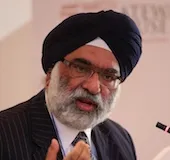
Covid-19 has severely impacted Japanese economic thought and action. The
opportunity loss of the Tokyo Olympics , spurred a domestic stimulus package. Of the $2.2 billion, $200 million supported business relocations from China to ASEAN.
India was not in the frame.
A
JETRO survey of Japanese Companies in India (April 2020) made dismal reading. According to it, before Covid-19, 40% of Japanese companies sought FDI expansion in India but
post Covid the number had reduced to 6.9%. Its results were shared with the Government of India (GOI) to realise the obtaining negative sentiment. However, by August 2020, the business sentiment seemed considerably altered.
The METI Minister, Hiroshi Kajiyama, indicated the readiness of 200 companies to invest in India provided conditions are right.
What has happened in the interregnum to see such an uncharacteristic rapid change in attitude? Perhaps it is the thinking of the government in Tokyo which guides Japanese businesses to view India as a strategic partner which must be included in Japan’s value chains. The Quad expanding to strategic investment patterns and creating regional and global value chains is likely to be discussed between India, Japan and Australia in September. The corollary to that is stable Japanese FDI in India if the new partnerships are to be successful.
The Quad expanding to strategic investment patterns and creating regional and global value chains is likely to be discussed between India, Japan and Australia in September.
A survey concerning the impact of Covid-19 on Japanese Companies in India (24-28 April 2020) obtained 558 responses from the 1441 companies in India. 82.3% reported disruption of business; 76% decreased sales with 16% losing half their sales; 56% had serious cash flow issues. 90% of the manufacturers saw disruption of supply chains while 80% ceased production. This segment sought urgent remedial action which Japan discussed with GOI in May.
Of the 547 companies who responded to the Outlook for Investment in the Survey, 308 (56%) gave a bleak picture saying no investments were planned. 38 (6.9%) planned new investments based on post Covid scenario. These figures were emphasised in April. Now, the focus is on the 201 companies (36 %) who had pre Covid plans for investing in India. It is these who are the strike force that is being prepared. 88 of 234 companies (37%) had opted out of new investment but 22 (9.4%) were ready to go ahead without delay and 124 (53%) were expecting delays but were ready to proceed thereafter. These trends are now tapped to restore the level of Japanese FDI into India on a strategic basis. A new survey underway is likely to show more positive trends and will be the deal setter by the time the Modi-Abe Summit is held. While companies revive FDI plans, these will now be medium and long term rather than the pre Covid shorter term intentions. Japan intends to show its intention to invest in India as the firm basis of the
Special Strategic Global Partnership.
While companies revive FDI plans, these will now be medium and long term rather than the pre Covid shorter term intentions.
The Japanese concerns are mainly those of manufacturing companies which are half the investors. These seem positively addressed by GOI. This will influence the mood change which the new survey will manifest. Among the matters addressed are the interstate movement of workers for reopening factories. This required coordination and showed satisfactory results due to which several automobile plants restarted. Another issue was the return of Japanese expatriates. Japan was not keen on a travel bubble as Indians were on
a higher check category for Covid-19 if returning to Japan. Since the bubbles are two-way systems, they were delayed.
Vande Bharat flights for Indians were permitted as well as charter flights to bring Japanese back to restart functioning in India. 32% of the companies had sent their expatriates back to Japan, while 33.5% had all their staff here. The flights arranged by the JCCI have facilitated this rise in confidence. This is important for installing new plant and machinery which is a positive sign of new investment. The easing of lockdown removed several of the Japanese concerns as well.
An outstanding issue pertains to cash flows.
Other issues include amendments to labour laws, clearing of dues by PSUs and large companies, early refunds of GST and taxes, and implementation of facilities offered to companies In India, which Japanese companies could also partake of.
An outstanding issue pertains to cash flows. The trend in Japan is for parent companies
not to send funds overseas at present in order to consolidate their home operations. However, if the new enthusiasm is to maintain itself, most Japanese companies need to revitalise through a dose of capital inflows from their parent companies to sustain their working capital requirements since borrowing in India is considered expensive. For this they seek relaxation of ECB rules to obtain working capital which RBI rules do not permit. If they secure this exemption, it will ease the investment plans.
India’s desire is to have more production of semiconductors and electronics as part of Atmanirbhar Bharat. This seeks some relocation or substitution from China.
The
India Japan Industrial Competitiveness Partnership established between METI and DIPP in December 2019 has served this revitalisation well. They have identified challenges of specific industrial sectors and the means to mitigate these. Their articulation of the issue of labour standards, laws and training have been integrated in the main. The issue of market expansion of the auto component industry by avoiding import of dubious non-OEM components from other countries, mainly China, will be a multiplier. This will relocate market instead of industry by improving quality of Indian components to join the export value chains. ACMA and JETRO are to prepare a report on this to expand capacities and markets for auto components. The harmonisation of quality standard certification with ASEAN will be tried to promote new RVCs.
India’s desire is to have more production of semiconductors and electronics as part of Atmanirbhar Bharat. This seeks some relocation or substitution from China. Japanese companies feel challenged by the labour standards and environmental law on water usage. They need to invest more in water recycling and training of work force in this sector which may need separate zones for quality appreciation and legal exception.
In the India-Japan-Australia RVCs, India must be the main beneficiary of new investment and supported competitiveness.
The FDI into India will not follow a relocation or China+1 strategy for now. The focus is on realising the FDI plans of existing companies. If the competitiveness of Indian companies improves then RVCs and GVCs will be easier. The proposed India, Japan, Australia value chain idea needs to identify competitive complementarities and enhance them for reliable supply bases. To be an important player in this, Indian competitiveness will be on test. Bilateral plans with Japan for improved auto components, digital partnership,
electronics, food processing, medical devices, logistics and trade facilitation will be factors determining the part India plays in such RVCs.
Non-lethal defence equipment, radar technology and robotics for HADR operations could be new starting points. The harmonisation with ASEAN standards in select sectors, and the review of the India ASEAN FTA on goods can contribute to bringing ASEAN into this venture but India needs to be wary that the benefits of such RVCs don’t just
pass on to ASEAN. In the India-Japan-Australia RVCs, India must be the main beneficiary of new investment and supported competitiveness.
For Japan the expansion of FDI in India will also focus on export markets. Despite the attraction of the Indian market, the nature of Japanese companies is to export and 60% of the 1,441 companies export up to 50% of their production to earn $2.5 billion annually. South Asia, USA and EU take 50% of these exports while ASEAN imports 26% and Japan itself 12%. 6% of Japanese companies exports from India are to China. The ASEAN, USA and EU are focus of export expansion. Africa is the new market in mind for which several
Japanese companies are expanding production bases in India to enhance entry into Africa. These will make India a regional or global production base for Japanese companies.
In the near future, possibly by the next Summit, Japan may announce a proposed plan for FDI of $1.5-2.5 billion.
Japanese investment in India between
2000-2019 is $30.7 billion of which $2.9 billion came in 2019. The effort now is to try and reverse the impact of Covid-19 and return to such levels of FDI. In the near future, possibly by the next Summit, Japan may announce a proposed plan for FDI of $1.5-2.5 billion. This will provide the impetus to indicate confidence in the Indian economy and the reforms undertaken. Japan is the largest provider of ODA to India (about $4 billion) with a 64% disbursement rate. This provides opportunities to Japanese companies to expand. The same pace is now pursued for FDI as a strategic goal. For Japan. economic engagement is the surest sign of a strategic partnership.
The matching of expectations will need to be managed. India wants FDI focusing on manufacturing and involving India in Japanese GVCS. Japan prefers the
Digital Transformation (DX) link between Japanese industry, financial strength and access to global markets to match with India’s IT core.
Rakuten is discussing 5G with Indian IT companies while Sojitz is discussing cold chains and investing in startups. If India will be part of Japanese led GVCs then Japanese companies will enhance the quality of their FDI and raise technology levels for competitiveness beyond the Indian market. In that lies a win-win possibility.
The views expressed above belong to the author(s). ORF research and analyses now available on Telegram! Click here to access our curated content — blogs, longforms and interviews.



 Covid-19 has severely impacted Japanese economic thought and action. The
Covid-19 has severely impacted Japanese economic thought and action. The  PREV
PREV


